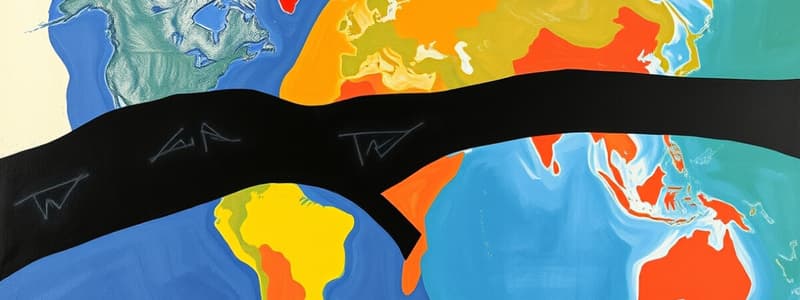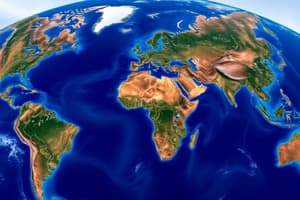Podcast
Questions and Answers
Who first proposed the theory of continental drift?
Who first proposed the theory of continental drift?
- Alfred Wegener (correct)
- Charles Darwin
- Harry Hess
- Isaac Newton
What evidence did Wegener provide to support his theory?
What evidence did Wegener provide to support his theory?
- Fossil Evidence
- Paleoclimatic Evidence
- Ancient Mountains and Rocks
- All of the above (correct)
The Continental Drift Theory was widely accepted at the time Wegener proposed it.
The Continental Drift Theory was widely accepted at the time Wegener proposed it.
False (B)
What is the Seafloor Spreading Theory?
What is the Seafloor Spreading Theory?
What is sonar used for in relation to seafloor spreading?
What is sonar used for in relation to seafloor spreading?
The Earth's lithosphere is broken into pieces called ______.
The Earth's lithosphere is broken into pieces called ______.
Which of the following is a driving mechanism for plate movements?
Which of the following is a driving mechanism for plate movements?
What is slab pull?
What is slab pull?
Match the following evidence types with their descriptions:
Match the following evidence types with their descriptions:
Flashcards are hidden until you start studying
Study Notes
Continental Drift Theory
- Proposed by Alfred Wegener, suggesting continents originated as a single landmass called Pangaea.
- Wegener's notable work: "The Origin of the Continents and the Oceans" (1915), which outlines his theory.
- Evidence for the theory includes:
- Puzzle Piece Fit: Continents fitting together like pieces of a puzzle.
- Fossil Evidence: Similar fossils found across different continents.
- Ancient Mountains: Matching mountain ranges on disparate continents.
- Paleoclimatic Evidence: Climate evidence indicating past connections between continents.
Rejection of the Continental Drift Theory
- Wegener's theory faced rejection due to the inability to explain the forces behind continental movement.
- Fossilized facts could not convince scientists of a viable mechanism for drift.
- Wegener passed away during an expedition in Greenland, with his hypothesis largely discredited at the time.
Sea Floor Spreading Theory
- Developed by Harry Hess, an American geologist, connecting to the idea of plate tectonics.
- Introduced in 1963, it explains the separation of once-joined continents into present-day configurations.
- Utilized sonar technology to map ocean floors.
- Evidence includes:
- Symmetrical patterns of rock material on either side of the Mid-Atlantic Ridge.
- Mid-Ocean Ridges: Underwater mountain chains where new crust is formed as magma rises and solidifies.
Supporting Evidence of Sea Floor Spreading
- Presence of active fractures in the ocean floor's lithosphere.
- Increasing age of seafloor rocks with distance from mid-ocean ridges.
- Increased sediment layer thickness as distance from mid-ocean ridges increases.
- Matching patterns of seafloor magnetism on both sides of mid-ocean ridges.
Plate Tectonic Theory
- Describes Earth's lithosphere as divided into plates that move over the asthenosphere.
- Convection currents in the mantle serve as the driving force for plate movements.
- Convection Process: Hot mantle material rises, moves horizontally, cools, and sinks back.
Causes of Plate Movements
- Driving Mechanisms:
- Convection cells within the mantle.
- Pushing at mid-ocean ridges.
- Pulling at subduction zones.
- Ridge Push: Force from rigid lithosphere sliding down the raised asthenosphere at mid-ocean ridges.
- Slab Pull: The downward force from cold, dense oceanic plates sinking into the mantle.
- Slab Suction: Occurs during subduction and influences mantle flow due to convection currents.
Studying That Suits You
Use AI to generate personalized quizzes and flashcards to suit your learning preferences.





